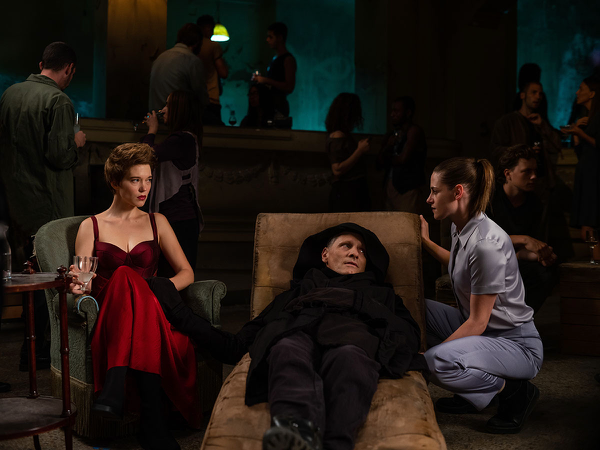Movie review by Greg Carlson
The newest David Cronenberg feature, “Crimes of the Future,” shares its name with the director’s own 1970 film, but the 2022 edition stands as a self-contained work and is not a sequel or a remake. The career-long preoccupations of the filmmaker, however, remain unmistakable. Cronenberg, whose movies are sometimes lumped in with lesser horror exercises, braids his creepy visions of the limits of the human body with a strong interest in the systems all around us – including politics and the consequences of bad decisions made sometimes by people with a lot of power and sometimes by people with virtually no power.
Viggo Mortensen plays the appropriately-named Saul Tenser, a curious performance artist whose ability to grow novel organs inside his body is matched by his capacity for what would have surely been excruciating pain in an earlier era. Despite the audience learning that humans have, in general, lost the ability to feel physical discomfort, Saul still writhes and emotes and grimaces and works very, very intimately with his partner Caprice (Léa Seydoux), a former trauma surgeon who now applies her special skills to the removal of Saul’s innards. People pay to observe this spectacle, which is carried out by an insectoid apparatus that makes incisions via a biomechanical controller.
Longtime Cronenberg collaborator Carol Spier, as ever, offers up this arresting gallery of concoctions with the delights that only practical effects can provide (love that feeding chair and sleeping pod). Spier’s invention of exoskeletal hybrids places her in rare company alongside the likes of H. R. Giger, but her work stands on its own as some of the most elegant and exquisite nightmare fuel ever committed to cinema. In total, “Crimes of the Future” routinely transcends its budgetary limitations to arrive at a painterly series of compositions reminiscent of the chiaroscuro of Caravaggio and Goya.
While decidedly not for all tastes, Cronenberg’s unique oeuvre is as deliberately erotic as it is disturbing. The relationship between Saul and Caprice is the irregular heartbeat of “Crimes of the Future,” and Mortensen and Seydoux give off showers of sparks in their onscreen partnership. We can only speculate as to whether the movie would have worked as well with rumored early-choices Ralph Fiennes or Nicolas Cage as Saul and Natalie Portman as Caprice, but I for one am glad that Mortensen reported for Cronenberg duty once again. “Crimes of the Future” doesn’t offer the same opportunities of mid-2000s highlights like “A History of Violence” and “Eastern Promises,” but Mortensen balances the ridiculous and the sublime like few others.
Additionally, Kristen Stewart – who playfully suggested she had no clue what the movie was about the entire time she worked on it – is also delightfully comic as National Organ Registry record keeper and Saul stan Timlin. Manohla Dargis, who attended the Cannes premiere, noted that “It’s certainly the only movie [at the festival] that solicits both your laughter and disgust, alternately entertaining you with macabre jokes and testing your limits with grotesque imagery.”
It is because of, and not despite, the viscera that “Crimes of the Future” succeeds as a romance. “Surgery is the new sex” may be nearly as wild a concept as the symphorophilia practiced by the inhabitants of Cronenberg’s 1996 adaptation of J. G. Ballard’s “Crash,” but the intimacies of Saul and Caprice, complemented by Howard Shore’s terrific score, are the most successful components of “Crimes of the Future.” Through the central relationship, Cronenberg freely explores the personal and the public, speculating on life, love, and the future in his inimitable way.
